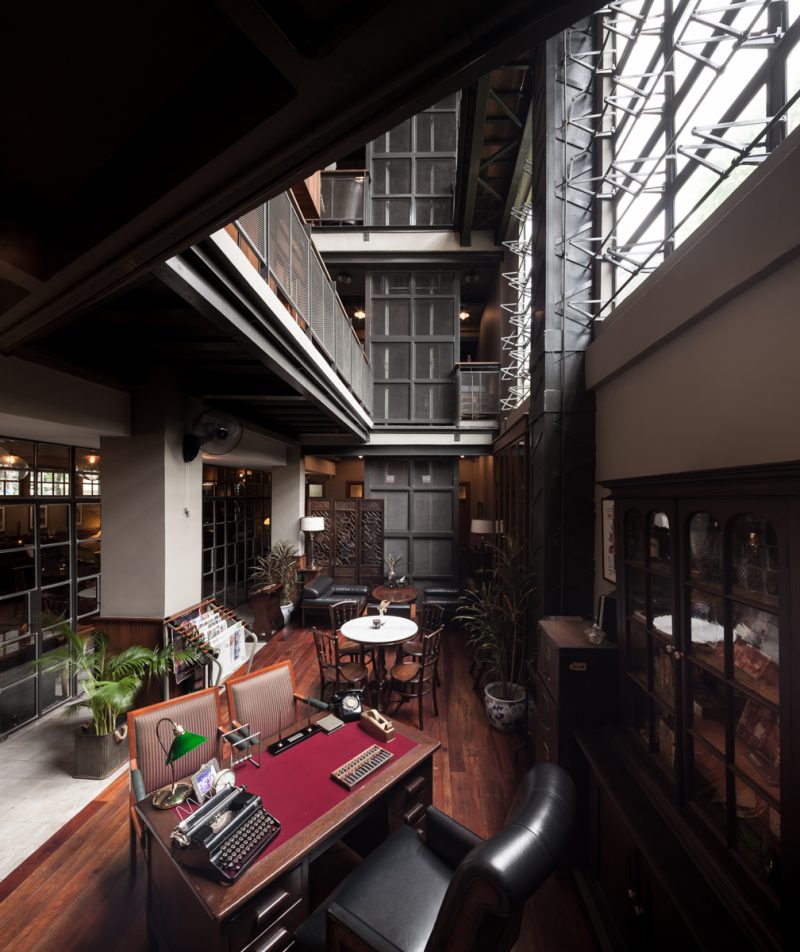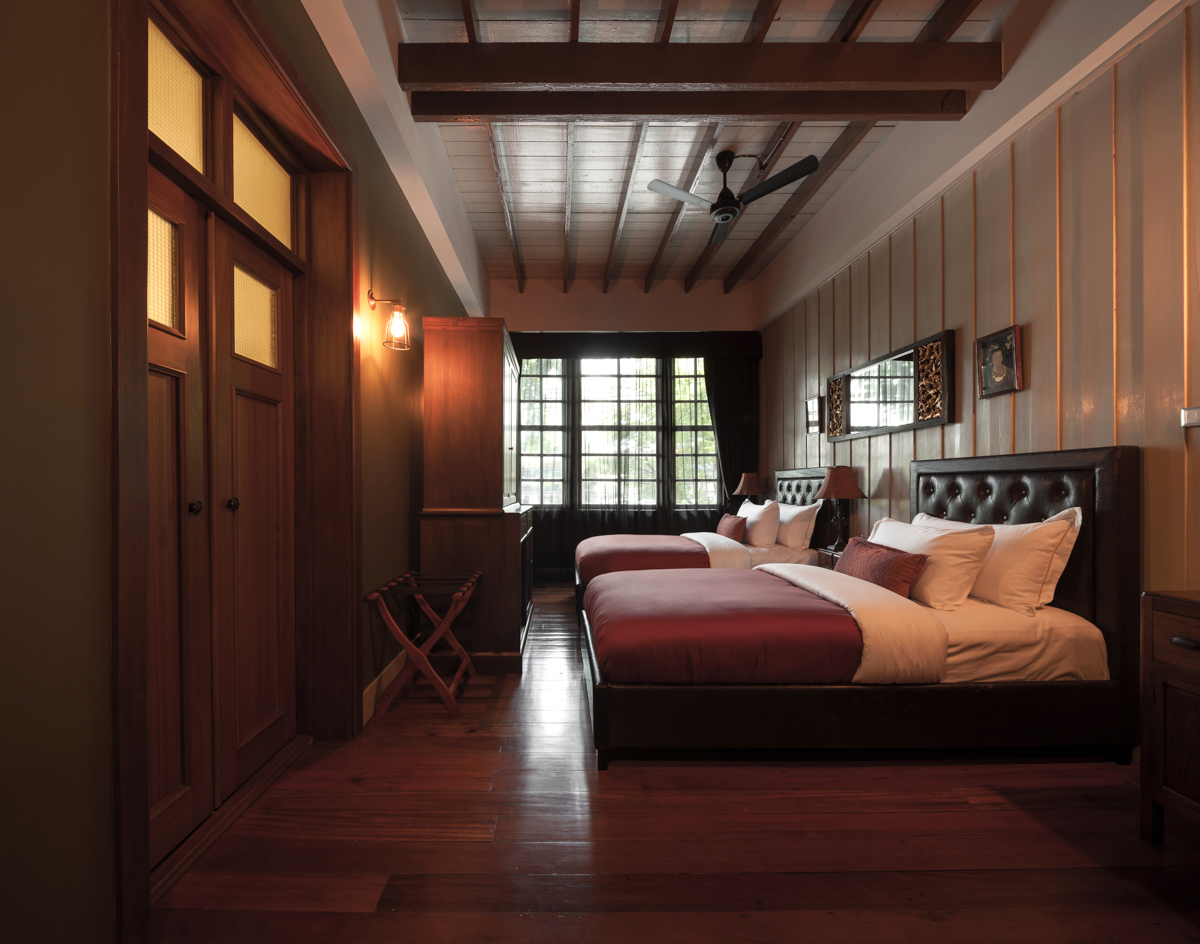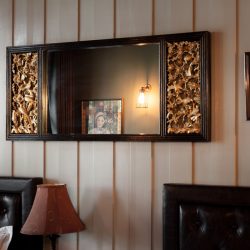The 3rd generation of Bangkok Publishing House adds a little drop of a hotel business into their building full of detail
The beginning of Bangkok Publishing Residence stems from the love for, and connection of, a family’s printing business that later inspired the renovation of the Bangkok office’s printing house on Lan Luang road into a hotel. Panida Tosnaitada, a third generation owner of Bangkok Publishing House, initially wanted to preserve the six units of the four-story shophouses as a museum where the history and works of Bangkok Publishing House could be brought together and exhibited. But with the potential of the location and the need for the business to be self-sufficient, Tosnaitada decided to combine the commercial functionality of a hotel into the program of a museum by limiting accommodation to eight rooms and choosing to curate the ambience of the space to be filled with the stories of printing in Thailand, as well as installation artworks under the 4Bs concept or Bed, Book, Breakfast and Beat.
A team of engineers and architects led by Saran Soontornsuk and Pongsakorn Kitkajornpong worked together toward the transformation of the building’s rather dense original structure (due to the functionality of the printing house) to be more spacious and ventilated. The ceilings of the four floors were opened, creating a foyer of spectacular spatial flow where every floor is physically and visually connected. The massive openings are located on the building’s interior walls, allowing for natural light to enter in through the industrial-styled window walls, warming and welcomingly bringing not only brightness to the first floor area but also a physical linkage between the interior spaces and the outdoor ambience. Walking past the wall into the inside of the building, one will come across the hotel’s lobby lounge. This particular area is used to host special concert sessions by independent artists. When entering the adjacent foyer, waiting is the area where breakfast is served with another lounge for the hotel guests surrounded by reading desks and towering bookshelves, simulating the atmosphere when the place was occupied by its previous activities back in the old days. The shelves store original copies of the works published by Bangkok Publishing House and other contemporary books, including photographs and personal artifacts of the previous generation’s owners.

The transition area in the lobby lounge that leads to the private space inside
The eclectic interior decoration stands out with its mixed style of furniture, from the primitive folk craft details of the chairs that are set side by side with the modern leather sofa to the combined aesthetics of the Art Deco and Oriental pieces, be they Chinese, Balinese or Thai. The mixture of styles where items from different places and times meet and mingle in the seemingly unintentional pattern creates a sense of wonder within the space, stimulating users’ interest in the presence of these decorative elements.
Tosnaitada’s personal attraction to books is in the way they reflect the attentiveness of the creators, whether through the content or the details of the production. Bangkok Publishing Residence’s narratives are meticulously created in a manner similar to the way they put a book together and, with Prakamkrong Pongpaiboon serving as the designer of the content and exhibition concept, the information the team obtained through the study of the area’s historical background can also be experienced. The content is divided into (1) Bangkok Publishing Company (2) Lan Luang neighborhood and (3) publications and printing machines. The data is transformed into the curatorial concept that directs the selection and installation of the exhibited objects as stories are interwoven in as a part of the hotel’s space. Among the exhibited items are such as the original copies of Bangkok Magazine, one of the publishing house’s most memorable works, which the hotel’s guests can flip through (and are kindly asked to wear gloves when touching). The miniature replicas of musical instruments placed among other decorative objects convey the entertaining characteristics of Lan Luang neighborhood in the past while the quotes from classical Thai literature published in the same time period as Bangkok Magazine are displayed on the walls in the form of neon signs. Everything has and tells its own story with the core structure of the narrative being presented according to the timeline, from the ground to the upper floors of the hotel as the program of the exhibition is designed for visitors to experience the narrative chronologically. In addition to ‘books’ and ‘reading,’ ‘writing’ is also what Tosnaitada holds in high regard and can be seen integrated in as a part of the decorative element such as the presence of a writing desk and a stationary set or the interior design of the hotel’s rooms where gimmicks related to old printing techniques are included.
Bangkok Publishing Residence is, without a doubt, a valuable piece of design from the way the history of printing and the Lan Luang neighborhood that served as a hangout spot for writers and folks from the publishing industry back in the 50s are beautifully preserved and portrayed, to the attentively curated experience of the ‘place’ where visitors are taken on a journey, into memories from a glorious time in someone’s life.


The idea to design 8 units of accommodation was called upon to create 8 different styles and personalities
จุดเริ่มต้นของ Bangkok Publishing Residence เกิดมาจากความผูกพันที่มีต่อกิจการสิ่งพิมพ์ของครอบครัว จนกลายมาเป็นแรงบันดาลใจในการผลักดันให้เกิดโครงการรีโนเวทตัวโรงพิมพ์ของสำนักงานบางกอก บนถนนหลานหลวง ให้เป็นโรงแรม โดยทีแรก ปณิดา ทศไนยธาดา ทายาทรุ่นที่สามของสำนักพิมพ์บางกอก ต้องการที่จะอนุรักษ์ตึกแถว 4 ชั้น ขนาด 6 คูหา นี้ไว้เพื่อถ่ายทอดประวัติศาสตร์และผลงานของสำนักพิมพ์บางกอกในรูปแบบของพิพิธภัณฑ์ แต่ด้วยศักยภาพของทำเลที่ตั้ง รวมทั้งความจำเป็นที่ต้องสร้างความยั่งยืนให้กับกิจการ เธอจึงตัดสินใจเลือกการผสมผสานกันระหว่างโรงแรมกับพิพิธภัณฑ์ โดยจำากัดจำนวนห้องพักไว้แค่ 8 ห้อง และเลือกให้บรรยากาศภายในอบอวลไปด้วยเรื่องราวของสิ่งพิมพ์ไทยและงานศิลปะจัดวาง ภายใต้องค์ประกอบที่เรียกว่า 4Bs นั่นคือ Bed, Book, Breakfast และ Beat
ทีมวิศวกรและสถาปนิก นำโดย ศรัณย์ สุนทรสุข และพงศกร กิจขจรพงษ์ ได้ร่วมกันเปลี่ยนอาคารเดิมที่ดูค่อนข้างทึบ (จากฟังก์ชั่นโรงพิมพ์) ให้โปร่งมากขึ้นโดยทะลุพื้นเพดานทั้ง 4 ชั้น เพื่อให้โถงส่วนกลางเชื่อมถึงกัน และเปิดช่องแสงขนาดใหญ่บนผนังฝั่งด้านในของอาคาร แสงที่สาดเข้าโถงผ่านบานกระจกในกรอบเหล็กสไตล์ industrial นอกจากจะช่วยนำความสว่างมาให้กับพื้นที่บนชั้นหนึ่งแล้ว ยังช่วยเชื่อมพื้นที่ภายในอาคารกับบรรยากาศภายนอกได้อย่างอบอุ่นเป็นมิตรอีกด้วย เมื่อผ่านกำแพงเข้าสู่ตัวอาคาร เราจะพบกับ lobby lounge ซึ่งส่วนนี้ยังถูกใช้เป็นสถานที่จัดคอนเสิร์ตเฉพาะกิจโดยศิลปินที่มีแนวทางการทำงานเฉพาะตัว เมื่อก้าวสู่บริเวณโถงกลางชั้นล่างที่อยู่ติดกัน เราจะพบกับพื้นที่รับประทานอาหารเช้าและพื้นที่นั่งเล่นสำาหรับแขกของโรงแรมที่รายล้อมด้วย โต๊ะเขียนหนังสือและตู้หนังสือสูงตระหง่านที่จำลองสภาพและห้วงเวลาขณะยังถูกใช้งานโดยผู้เป็นเจ้าของสำนักพิมพ์ ภายในตู้หนังสือนั้นบรรจุไว้ด้วยสิ่งพิมพ์ต้นฉบับของสำนักพิมพ์บางกอก หนังสือร่วมสมัยเล่มอื่นๆ รวมทั้งภาพถ่ายและข้าวของส่วนตัวของผู้เป็นเจ้าของสำนักพิมพ์
สำหรับแนวคิดของการตกแต่งภายในนั้น มีรูปแบบการตกแต่งแบบ eclectic ที่โดดเด่นด้วยการจัดวางเครื่องเรือนหลากสไตล์เข้าด้วยกัน เก้าอี้ไม้แนว primitive folk craft ถูกนำมาจัดกลุ่มเข้ากับโซฟาหนังตัวใหญ่จากยุคโมเดิร์น หรือเครื่องเรือนจากยุค Art Deco นำมาใช้ร่วมกับเครื่องเรือนสไตล์ Oriental ทั้งจีน บาหลี และไทย การ “คละ” สิ่งของจากหลายสถานที่และห้วงเวลาแบบไม่ต้องแคร์แบบแผนชวนให้เกิดความฉงนและการตั้งคำาถามเกี่ยวกับสิ่งของต่างๆที่จัดวางอยู่
ปณิดาเองมีความประทับใจกับหนังสือในแง่ที่มันสะท้อนความพิถีพิถันของผู้สร้างทั้งในเชิงเนื้อหาสาระและการผลิต การออกแบบเรื่องเล่า (narratives) ของ Bangkok Publishing Residence จึงได้รับการ curate ขึ้นอย่างพิถีพิถันเช่นเดียวกับกระบวนการทำาหนังสือ โดยมี ประคำกรอง พงษ์ไพบูลย์ เป็น ผู้ออกแบบเนื้อหาและแนวคิดของการจัดแสดง โดยอาศัยข้อมูลที่ทีมได้ทำาการศึกษาเชิงประวัติศาสตร์ของพื้นที่แห่งนี้ในประเด็นสำคัญ 3 เรื่อง คือ (1) สำานักพิมพ์ Bangkok Publishing Company (2) ย่านหลานหลวง และ (3) สิ่งพิมพ์และเครื่องพิมพ์ ข้อมูลเหล่านี้ถูกแปลงมาเป็นแนวคิดของการคัดเลือกและจัดวางวัตถุต่างๆ เพื่อถ่ายทอดเรื่องราวที่ซ้อนแทรกอยู่ภายในพื้นที่โรงแรม ทั้งนิตยสารบางกอก ผลงานสำาคัญของสำานักพิมพ์ฉบับ original ที่ผู้เข้าพักสามารถเอามานั่งดูได้ เพียงแต่จะถูกร้องขอให้ใส่ถุงมือก่อนสัมผัสตัวนิตยสาร เครื่องดนตรีจำลองขนาดเล็กที่แทรกอยู่ท่ามกลางของตกแต่งชิ้นอื่นๆ สื่อถึงความเป็นย่านมหรสพที่หลานหลวงเคยเป็นมาในอดีต รวมไปจนถึงประโยคทองจากวรรณกรรมไทยคลาสสิคจากยุคเดียวกับนิตยสารบางกอกที่ทำขึ้นเป็น neon sign บนผนัง ทุกอย่างล้วนทำหน้าที่ในการเล่าเรื่องของมันได้อย่างน่าสนใจ นอกจากนี้ยังกำหนดให้โครงสร้างการเล่าเรื่องนั้น เล่าตามไทม์ไลน์ของเวลาจากชั้นล่างไปสู่ชั้นบน คือ เราจะพบเรื่องราวที่เกิดขึ้นก่อนบริเวณชั้นล่างสุด เมื่อขึ้นสู่ชั้นสอง สาม สี่ ก็จะพบเรื่องราวที่เกิดขึ้นในช่วงเวลาถัดมาตามลำดับ โดยนอกจากเรื่องของ “หนังสือ” และ “การอ่าน” แล้ว ปณิดายังให้ความสำคัญกับ “การเขียน” อีกด้วย โดยสอดแทรกเรื่องการเขียนลงในองค์ประกอบต่างๆ ไม่ว่าจะเป็นการวางโต๊ะเขียนหนังสือพร้อมชุดเครื่องเขียนและชุดของใช้ ในห้องพักของแขกที่ออกแบบให้มีลูกเล่นเชื่อมโยงกับเรื่องของการพิมพ์สมัยก่อน
อาจกล่าวได้ว่า Bangkok Publishing Residence เป็นผลงานการออกแบบที่มีคุณค่า ทั้งในแง่ของการรักษาและถ่ายทอดประวัติศาสตร์ของสิ่งพิมพ์ไทยและของย่านหลานหลวง แหล่งแฮงค์เอาท์ของนักเขียนและคนในวงการสิ่งพิมพ์ในยุค 50s สำหรับผู้มาเยือน การก้าวเข้าสู่สถานที่ที่เรียกว่า “ที่พัก” แห่งนี้ ให้ความรู้สึกเสมือนว่าเรากำาลังออกเดินทางไปยังช่วงเวลาอันเรืองรองในความทรงจำของใครบางคน
TEXT: NANTHANA BOONLA-OR
PHOTO : KETSIREE WONGWAN
bpresidence.com







